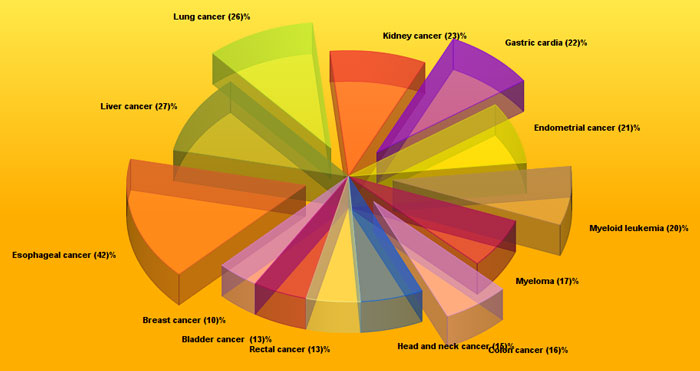Exercise cuts your risk for 13 types of cancer

If you frequently work out, this will come as great news.
Regular exercise improves your odds against being diagnosed with at least 13 different types of cancer – that we know of so far.
Exercise has been known to reduce the risks of certain cancers and tumors for some time.
We’ve long known for instance, that regular exercise can decrease occurrences of breast cancer, lung cancer, and many colon cancers.
The catch however, is that these results where gleaned from studies specifically looking at a limited number of cancer types.
At least, until now.
A new study published in JAMA Internal Medicine has now taken a much wider look and discovered that exercise improves your odds against 13 different types of tumors and cancers.
The new study spanned 11 years, and included 1.44 million people.
Across the United States and Europe, subjects from 12 different study groups were followed for 11 years. Participants were asked to rate their activity level during leisure time – sedentary, moderate or vigorous exercise.
During the study period, over 186,000 cases of cancer were diagnosed in participants of the study – and study subjects who engaged in the higher levels of leisure-time activity were significantly less likely to be among that number.
Types of Cancer Affected
26 different types of cancer were considered in the study results, and 13 (or half) of these showed significantly reduced risk in the frequent exercise group. Esophageal Adenocarcinoma saw the most improvement with a 42% lowered risk factor.
Other cancer types include liver, lung and kidney cancers. See the complete list below:
- Esophageal cancer – risk reduction: 42%
- Liver cancer – risk reduction: 27%
- Lung cancer – risk reduction: 26%
- Kidney cancer – risk reduction: 23%
- Gastric cardia (upper stomach cancer) – risk reduction: 22%
- Endometrial cancer – risk reduction: 21%
- Myeloid leukemia – risk reduction: 20%
- Myeloma – risk reduction: 17%
- Colon cancer – risk reduction: 16%
- Head and neck cancer – risk reduction: 15%
- Rectal cancer – risk reduction: 13%
- Bladder cancer – risk reduction: 13%
- Breast cancer – risk reduction: 10%

Obesity Weighs in on the Results
Exercise or activity level wasn’t the only factor at work here. Fitness level plays a key role.
Healthy BMI ranges from 18 to 24, and obesity starts at 30. The average Body Mass Index (or BMI) for participants was 26. This puts the average study subject squarely in “overweight” territory – meaning that a significant number of participants were either overweight or obese.
This should not come as a major surprise, given that at this time approximately 2 out of 3 people are overweight in the United States and one of those two is obese. Europe isn’t far behind with roughly half of the population overweight and 22% obese.
Cancers such as liver cancer, gastric cardio, kidney cancer, esophageal adenocarcinoma and endometrial cancer are all known to be linked to body weight already. We should be more motivated to lose weight than ever before - yet obesity rates continue to climb.
If you are overweight or obese, you should be aware that your risks of developing these and other cancers including breast cancer and prostate cancer are already significantly higher than those of someone maintaining a healthy weight.
When these risk factors were accounted for, the links between exercise and reduced cancer risks remained. While BMI does increase the risks significantly, frequent exercise still accounts for a major risk reduction by itself.
Smoking history was also taken into account, and did not significantly affect the results.
Cancer Types Unaffacted or Increased
The results were very promising, but they only turned up across half of the board.
Cancers unaffected by exercise levels included non-Hodgkin lymphoma, thyroid cancer, ovarian, brain cancer and more.
Of more interest were two specific cancer types that actually saw an increase with higher exercise levels: malignant melanoma and slow-growth prostate cancer.
The increase in diagnosed prostate cancer was approximately 5%. While there is no clear-cut explanation, one theory is that regularly active men are more likely to get regular medical checkups. More regular checkups would mean an increased discovery rate for a cancer type that is otherwise difficult to notice until it reaches later stages.
Malignant melanoma increased 27% for the exercise group, but this connection is easier to explain. Those pursuing activities and exercise regularly are far more likely to spend extended amounts of time outside – and skin cancer often goes hand-in-hand with increased time outdoors and lack of proper sunscreen protection.
Why it Works
Now that we know exercise can actively reduce your risk of developing many kinds of cancer, one question still remains: How?
The answer is far from simple, but we have some ideas.
Hormone Balance
There are a number of hormones that play pivotal roles in the daily operation of your body, and exercise has been shown to effect which ones (and how much of them) are produced. This could certainly have direct consequences to cancer risk factors.
Insulin: Consistent and regular exercise has been shown to improve the way your body uses insulin – the crucial hormone responsible for triggering conversion of sugar in your blood. This is extremely helpful in managing Type 2 Diabetes, and also has a positive impact on certain cancer risks.
Cortisol: When you’re stressed, your body produces increased levels of Cortisol. This hormone controls your energy levels and helps the body maintain a heightened state of capability – intended to facilitate a “fight-or-flight” reaction. Your metabolism slows, your immune system goes into low-power mode, your blood pressure rises and your body stands ready for emergency action. While this is helpful in genuinely dangerous short-term situations, it can be devastating to your body during times of chronic stress. The damage caused by extended periods of increased cortisol production could certainly play a role in cancer risks.
Estrogen and Testosterone: Responsible for far more than sexuality, both of these hormones are in fact found in both sexes – simply in larger or smaller quantities depending on gender. In an interesting cycle, both testosterone and estrogen are involved in how the body deals with fat – and excess body fat can affect how the body deals with the hormones. Excessive testosterone has been suggested to increase likelihood of prostate cancer, though this theory is contested. Estrogen meanwhile – especially in excess – has been linked to uterine and breast cancer.
Growth Hormone: Most people are aware that growth hormone production is increased when you exercise regularly. This results in bone strengthening and muscle mass, but there are other effects as well including improved gluconeogenesis of the liver (improves blood sugar levels) and increased breakdown of fatty acids. Growth hormone also stimulates the immune system and helps maintain proper functioning of the pancreas.
Circulation and Digestion
Exercise improves blood flow throughout the body – which by default improves oxygenation of the tissues. According to some sources, an underlying cause of cancer is low cellular oxygenation – therefore increased circulation due to exercise would have a direct effect on your risk levels.
Exercise also keeps your body flexible and moving – which in turn keeps your digestive system running more smoothly. The improved circulation helps with digestion efficiency as well.
Could improved digestive tract health reduce your risk of developing digestive tract related cancer? Perhaps. Often the material passing through your system contains carcinogens – so keeping it moving and on its’ way out in a timely fashion can’t hurt your odds.
What’s Next?
That answer should be obvious – if you’re not in the habit of regular exercise, get out there and get started!
The sooner you take control and turn things around, the better your future can be.
Just don’t forget to wear your sunscreen.
How did we do?

Rated 4.2 of 5 Stars by 150 readers.


